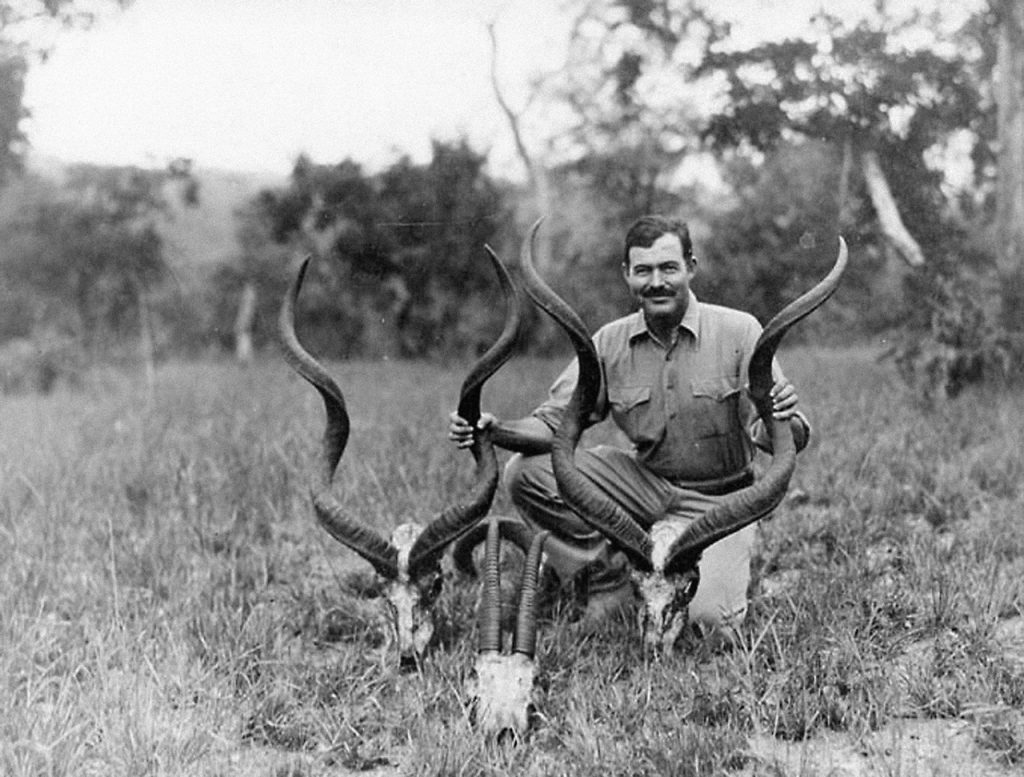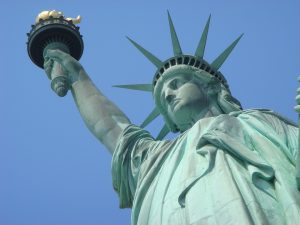Ernest Miller Hemingway, world-renowned American author and journalist, lived his life to the fullest. From a young age, Hemingway traveled around the globe as a journalist, soldier, and as a resident. Serving in both World Wars and influencing foreign conflicts by doing things like reporting on the Spanish Civil War, he experienced a great variety of cultures and people. As an author, his work had great literary merit, earning a Nobel Prize in Literature and the Pulitzer Prize for one of his later novels, The Old Man and the Sea.1.

Apart from composing literary masterpieces, Hemingway indulged in a multitude of activities, especially in different outdoor ventures. His two biggest passions were fishing off the coasts of Florida and Cuba and big-game hunting.2 In particular, he went hunting with one of his wives for months at a time. Hemingway’s life outside of writing was extremely busy, though his expeditions were often what brought his fictional stories to life.
Hemingway grew up going on hunting trips in and around Michigan with his father, and later he often traveled to foreign countries to hunt big game. One of his expeditions to Africa inspired the short story, The Short Happy Life of Francis Macomber. Taking place in a safari, the narrator Macomber, accompanied by his wife, faces the underlying consequences for showing fear as a hunter.3 Hemingway was a chaser—one who pursued his passions and values above regardless of their consequences. If Hemingway was interested in something, he would dive into it for large portions of his life.
In December of 1954, Hemingway and his wife Mary spent their holiday in an African safari, traveling by plane to the Congo. Unfortunately, while on a flight, their pilot collided with a telephone pole while they were flying at a low altitude. This crash injured the three people on board, and rendered them of minor to medium levels of injury. The entire party required medical assistance, stranded in the wilderness. The group opted to wait out the night, all while being surrounded by elephants who resided near the crash site.4
The next morning after being returned to camp by locals, Hemingway was prepared for takeoff to a local hospital for treatment of his injuries, along with his wife. Just as liftoff began, the plane suddenly was engulfed in flames, trapping the Hemingways and the pilot in a fireball. Barely escaping with their lives, all of the people on board were critically injured, with Hemingway suffering burns and even leaking cerebral fluids. After surviving two consecutive plane accidents, Hemingway took months to recover, spending most of that time restricted to a hospital bed. And with great luck, Hemingway was able to read the headlines that mistakenly reported his death after the crash; the man who knew the face of death dearly once again cheated an untimely fate.5

Hemingway was a man of grit who saw injuries barely restricting his wants. Only a couple months after the two accidents, Hemingway, more injured than his wife, went on and subsequently had trouble traversing on a fishing trip. Almost as quickly as the trip started, it ended in another tragic incident. Caught in a bush fire, Hemingway was burned all over his body, second-degree burns spread across his arms and face.6. Amazingly, and not surprisingly, Hemingway escaped the event without any major injuries. However, the series of catastrophes eventually led to his extended abuse of alcohol, a factor of his later life from which he would not escape free from damage.7 .
The next year, Hemingway was bedridden, constantly sick from a weakened immune system from a series of illnesses, including pneumonia. Eventually, in 1960, Hemingway checked into the Mayo Clinic in Minnesota to seek medical help. Oddly enough, his visitations to the clinic were mostly kept secret, and the FBI helped keep the incident classified.8 In the end in 1961, Hemingway was released from the clinic worse than when he entered. After an apparent suicide attempt, Hemingway was sent to the Sun Valley hospital until late June.9.

In the early morning of July the 2nd, Hemingway committed suicide in his Idaho home, at 61 years old.10 For him, a major downward spiral began after the plane crashed in the Congo. In a somber sense, Hemingway’s existence would have merely continued his depression and discontent if he had not committed suicide. Without knowing the life of Ernest Hemingway, readers would never fully understand the significance of his works. All authors write literary works for personal reasons, and the reason authors are so passionate about their work lies in their own backgrounds. As for Hemingway, his works symbolized the attrition he felt while working several roles he played in his life.
People may think Hemingway’s life reeked of bad luck, as a lot of his adult life was either marked by injury or a call to action on the battlefield. To Ernest Hemingway, this pain was fuel for his pen. Despite his unfortunate demise, his life was not wasted. Hemingway was not a coward for his actions. It could be argued that his exposure to the world and the connections he had to political conflicts caused his choice to take his life. In his later life, he was heavily surveyed by the CIA. He sensed their presence and felt quite skeptical. As with many literary figures, whose fame rises after their life has passed on, Hemingway’s greatest fame came after his death. For Hemingway, it always came easy to see what was worth living, and he wrote these words to share with the world.
- Linda Wagner-Martin, Ernest Hemingway: A Literary Life (New York: Palgrave Macmillan, 2007) 10-13 ↵
- Verna Kale, Ernest Hemingway (London: Reaktion Books, 2016). 30-32 ↵
- Linda Wagner-Martin, Ernest Hemingway: A Literary Life (New York: Palgrave Macmillan, 2007) 40-44. ↵
- Mary V. Dearborn, Ernest Hemingway: A Biography (New York: Knopf, 2017) 45-47 ↵
- Linda Wagner-Martin, Ernest Hemingway: A Literary Life (New York: Palgrave Macmillan, 2007), 90-94 ↵
- James M. Hutchisson, Ernest Hemingway: A New Life (University Park, Pennsylvania: The Pennsylvania State University Press, 2016) 148-152 ↵
- James M. Hutchisson, Ernest Hemingway: A New Life (University Park, Pennsylvania: The Pennsylvania State University Press, 2016) 219-223 ↵
- Verna Kale, Ernest Hemingway (London: Reaktion Books, 2016), 150-155 ↵
- Linda Wagner-Martin, Ernest Hemingway: A Literary Life (New York: Palgrave Macmillan, 2007) 183-187 ↵
- James M. Hutchisson, Ernest Hemingway: A New Life (University Park, Pennsylvania: The Pennsylvania State University Press, 2016) 246-447 ↵



35 comments
Mara Martinez
I didn’t really know much about Hemingway in this way until I read the article. It truly is interesting how so many people can have nature so against them but they don’t take the hint and still get to walk away and tell others about it. Surviving two plane crashes is crazy to me. How one can be so okay with getting on a plane even after the first crash baffles me, I could never. This article was very well written on how he went through it all and led to really good books written by him.
Hector Membreno
This is a very interesting reading. It is quite unfortunate that Ernest Miller Hemingway was so unlucky. It is quite inspiring that he did give up on the things he loved doing even though it would have been wise for him to stop going on these outdoor that always ended in injury. It is also extremely sad that his strive to do things he loved eventually led to him falling into depression and eventually killing himself.
Sebastian Portilla
Very interesting article! Ive been reading Hemingway since the 7th grade and his work is remarkable. Its extremely frightening and very unlucky to be stuck in those situations. His literature is known around the world and studied in many high schools and universities . No one every really mentioned his life or events. I always wondered the back ground of Hemingway.
Mauro Bustamante
I hadn’t known that Hemingway went through suffering burns and even leaking cerebral fluids. And After surviving two consecutive plane accidents, Hemingway took months to recover, spending most of that time restricted to a hospital bed. Its just goes to show that anything can happen and life is to short so enjoy it, Ernest Miller Hemingway, world-renowned American author and journalist, who went hunting with his father and enjoyed life with his wife and family. And also the fact that Hemingway’s greatest fame came after his death it goes to shows that he didn’t ;et the events that happened to him effect he way he lived his life. This article was inspiring and well written.
Jake Mares
What an accident prone human… it truly does seem like a miracle that Hemingway seemingly had all of nature against him and still could tell the tale of it. His literature is still widely known throughout the world today, so these events must have inspired some great stories. Such a crazy life with such a sad ending.
Sebastian Azcui
I had no idea that Hemingway suffered and went through this tragedy in his life. That crash made his life miserable and changed him completely. The positive thing is that thanks to this experiences he was able to do some of the best works in literature and amazed many people with what he wrote. He fought through these tragedies and is an example now a days.
Azucena Cuevas
The article is written with such detail and emphasis on Hemingway’s most tragic moments and how they added “fuel” for his writing. Hemingway lived a life of excitement, although most of his great stories were tragic to him. He seemed to have lived with such bravery and style as well. It is interesting how after two consecutive plane crashes he still went out for another adventure.
Charli Delmonico
This article was incredibly interesting! I had heard of Hemingway before, but I had no idea that he had endured fatal accidents during his lifetime. The odds of such catastrophic events happening to the same person over and over is almost ridiculous, and it makes me question what kind of mental traumatic effects the accidents must have had on his perception of life. I’m surprised that Hemingway got into a plane again after the first accident.
Briley Perkins
I have read some of Hemingway’s books and he is a great writer. Although I have read some of the books, I did not know he went through such a tragedy he went through in his life. That crash led his life to be sad and after living crazy adventures it must have been very hard for him. Through the experiences he had to endure in his life, he created some of the greatest works in literature. Great article I really enjoyed it.
Rahni Hingoranee
Living through that many near-death experiences is bound to give someone inspiration to write. Ernest Hemingway is an icon in the area of literature. The fact that he put the seemingly terrible experiences to positive use to better his career is inspirational. His tragic end is saddening to hear about. think this article was well structured in the sense that it was easy to follow and informational.